作物地小气候zuowudi xiaoqihoumicroclimate in the crop fields
在种植作物的农田上,形成的一类农田小气候。按作物种类可细分为水稻田小气候、麦田小气候、棉田小气候、玉米地小气候等;按作物特点可分为高秆作物地小气候、矮秆作物地小气候等;按作物叶型特点可分为禾谷类作物地小气候、阔叶类作物地小气候等。
形成 农作物生长在贴地气层和土壤上层,作物所受的气候条件不同于裸地上的小气候条件,造成这种差异的根本原因:一方面由于有了农作物,使到达作物地的太阳辐射以及热量、水汽、动量的交换过程都具有自身的特殊性;另一方面由于作物是具有生命活动的有机体,小气候条件制约着农作物的生长发育,使之形成一定的群体结构。反过来,农作物的群体结构又影响作物地小气候条件的形成。他们之间存在着相互依赖、相互制约的关系。了解和研究这种关系,对于充分利用以及改善和调节作物地小气候条件,提高作物单位面积产量是有实际意义的。
分布 作物地小气候条件,一般指作物层内的辐射、风速、温度、湿度、CO2等和作物生长发育有关的小气候要素的时空分布和变化的规律、特征以及土壤上层的温、湿度状况。同一块农田,由于作物种类、种植密度、种植方式、作物生育期和耕作措施的不同,都可造成作物地小气候条件的差异。在作物生育初期,因个体较小,对其下的下垫面影响不大,作物地小气候条件主要受原下垫面条件——土壤表面性质的影响,其小气候特征与裸地小气候相仿。随着作物生育期的进展,单位面积上作物生长量的增加,逐渐形成作物层,即新下垫面的形成,作物地小气候特征与裸露地的差异就愈来愈大,形成作物地特有的小气候特征。
辐射 太阳辐射到达地物上表面时,作物各器官对太阳辐射都有反射、吸收和透射作用,这些作用的强弱与作物本身的特征(作物种类、生育期、种植方式等)有关,同时又反过来影响作物本身的生育。不同作物或同一作物不同生育期,对太阳辐射的反射、吸收和透射能力是不同的。各种作物地的反射率变化的幅度各有一定范围(表1)。
表1 各种作物生育期内的反射率
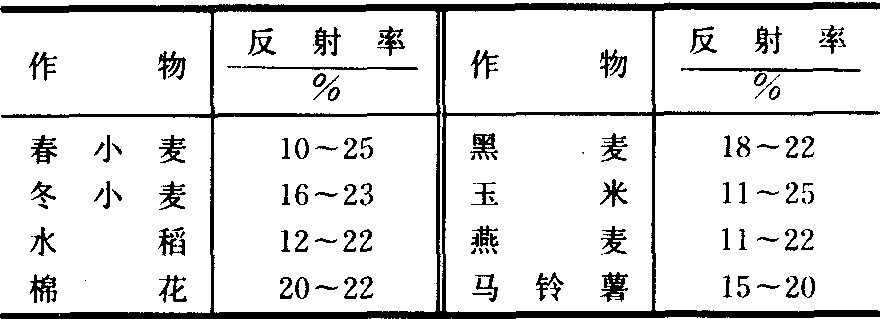
同一作物,同一生育期,由于太阳的周日变化,作物地的反射率也具有明显的日变化,变化幅度也因作物不同而有差异(图1)。
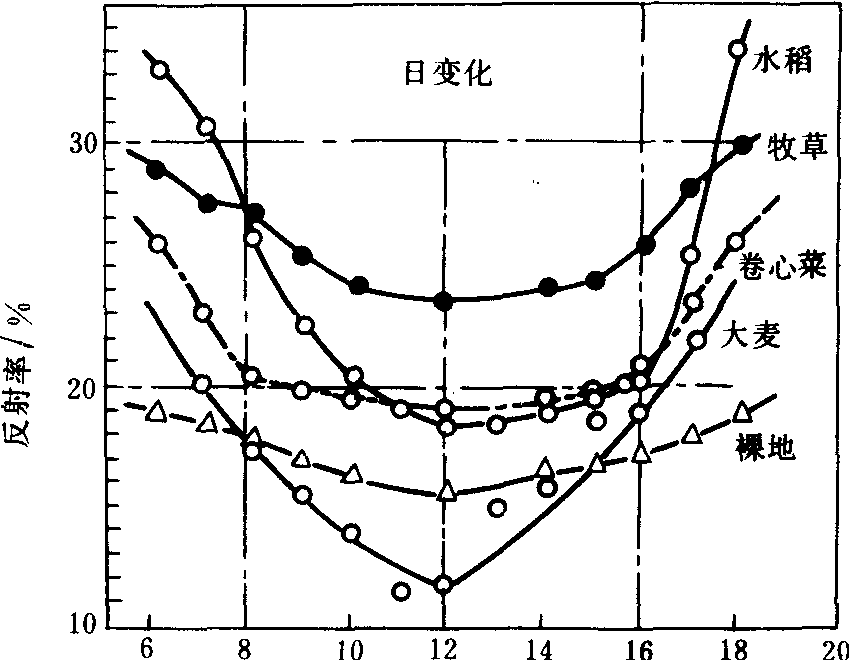
地方时间/h
图1 作物地反射率日变化
太阳辐射进入植被层后,受到茎叶的层层吸收、反射而被削弱,形成固有的垂直分布曲线,各种作物层内,太阳辐射垂直分布曲线趋势基本相似,都是从植株顶部向下递减,即在开始时递减缓慢(曲线垂直向下),然后在中间层迅速削弱(曲线明显倾斜),再往下,递减速度又缓慢下来(图2),而且随着作物叶面积指数的增大,递减愈迅速。水平叶作物比直立叶作物递减快(见作物群体结构)。因此,过分密植的作物,特别是水平叶作物,不利于下层透光, 自然也不利于作物更有效地利用光能。采用间套作和培育适当的株型,对有效利用太阳光能是很重要的。
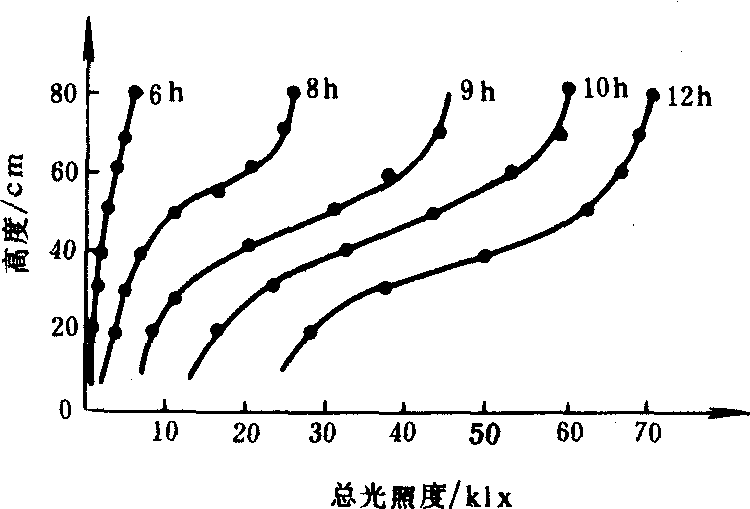
图 2 小麦田中各时刻总照度的垂直分布
作物层内各个高度上的光照度日变化形式是一致的,都是中午最大,早、晚趋于零。但各高度上变化幅度不同, 上层日变幅大, 下层日变幅小(图3)。
作物地就整体而言, 是一个由地面至作物上表面的活动层, 但由于各种农作物具有不同的群体结构, 使得各种作物地的辐射平衡状况也不一致。表2数据反映了棉花、冬小麦、水稻三种作物地辐射平衡的差异。造成这种差异的原因, 主要是与作物地反射条件和活动面温度有关。
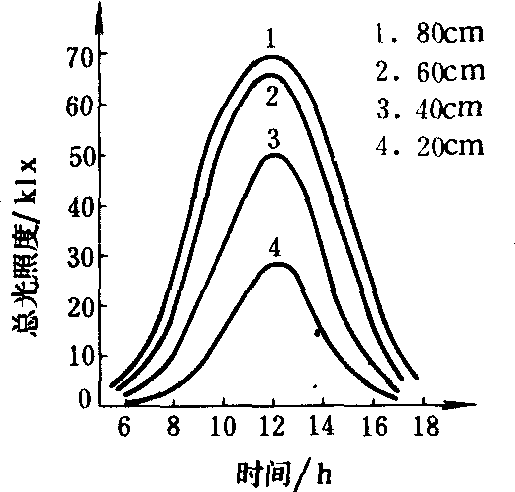
图 3 晴天小麦地中各高度
光照度的平均日变化
(株高95厘米 山西交城1978年6月3~12日平均)
表2 晴天三种作物地辐射平衡日变化(J·cm-2·min-1)
(1978年6月11日~20日平均 山西交城)
| 时 作物 | 6 | 8 | 10 | 12 | 14 | 16 | 18 | 20 | 22 |
| 棉 花 小 麦 水 稻 | 0.040 0.045 0.050 | 0.385 0.430 0.472 | 0.654 0.831 0.895 | 0.755 0.986 1.061 | 0.616 0.832 0.885 | 0.290 0.473 0.445 | -0.030 0.030 0.010 | -0.115 -0.091 -0.120 | -0.110 -0.088 -0.107 |
各种作物地中辐射平衡的垂直分布与太阳辐射垂直分布有某些相似 (图4), 白天, 辐射平衡都由作物上层向下递减, 到达地面辐射平衡比较少, 其中尤以叶片呈水平状排列的棉花地中递减最迅速。夜间, 整个农田辐射平衡反过来由作物上表面向下递增, 而且不论何种作物, 只要覆被茂密, 作物下层的辐射平衡都接近于零。
热量平衡 在农作物整个生长发育过程中, 各项热量消耗是有变化的。在作物枝叶繁茂的生育盛期,由于作物大量蒸散, 作物地所得的辐射热量(R)大部分都消耗在蒸散(LE)上,湍流热交换(P)比较少,土壤热交换(Qs)更少。由此可见热平衡各分量的分配情况、作物地与裸地是有明显区别的, 见表3。
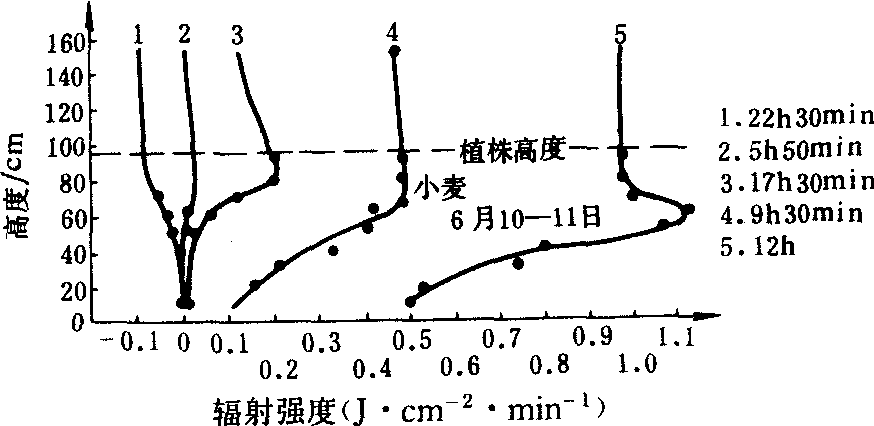
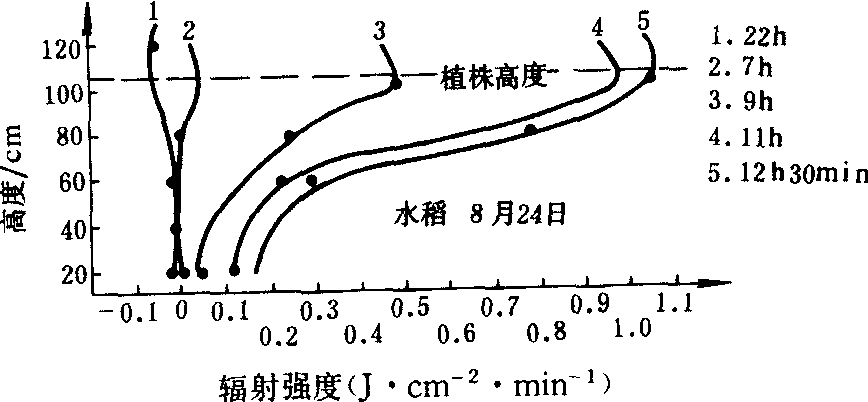
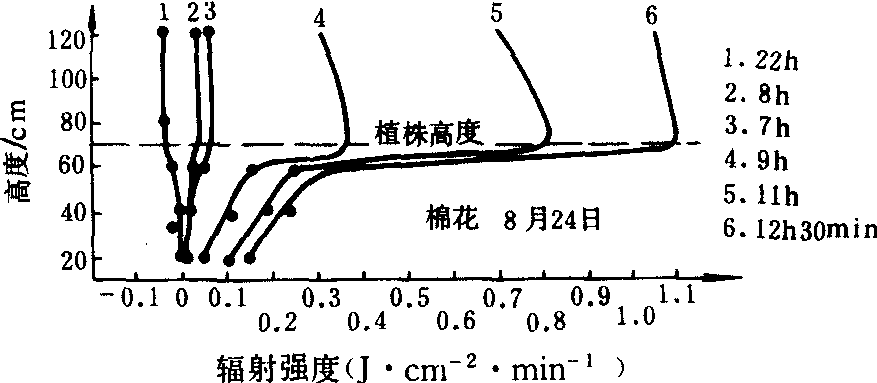
图 4 晴天各种农田辐射平衡的垂直分布(交城 1978)
作物层中显热通量、蒸散耗热量和辐射平衡一样随高度也有变化, 白天变化大, 夜间变化小。旱地作物显热通量为正值,随高度增加而增大;水稻田白天上层显热通量为正值,下层为负,而且绝对值小(图5)。
表3 棉花各生育期热量平衡各分量的平均值(J·cm-2·min-1)
| 生育期 项目 | 4叶-孕蕾 | 孕蕾-开花 | 开花-裂铃 | 裂铃-收获 |
| R P LE Qs | 294 174 110 10 | 283 145 135 2 | 377 69 246 2 | 153 72 84 -3 |
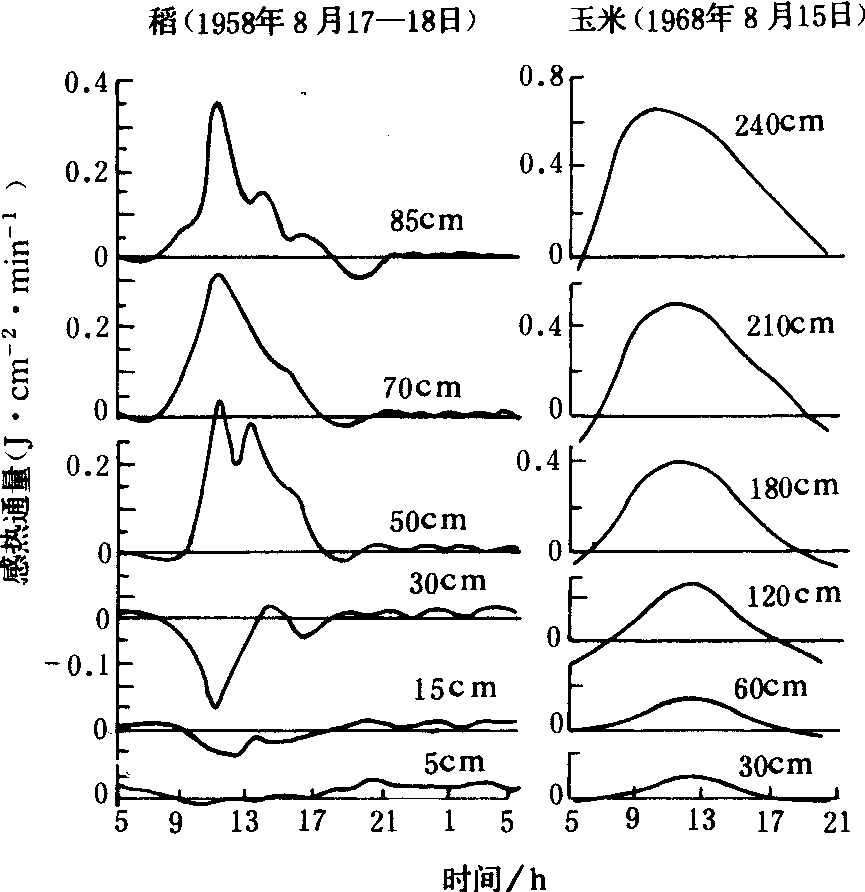
图5 作物地中显热通量的垂直分布和时间变化
蒸发耗热量(与水汽通量成正比)不论水稻田还是旱地作物都呈随高度增加而增大(图6)。
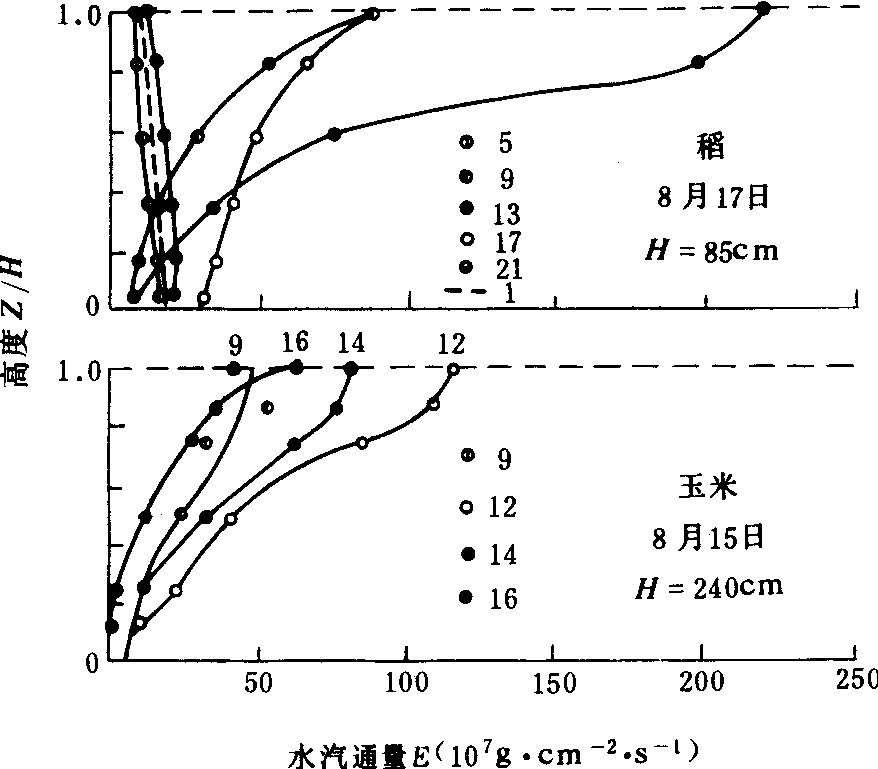
图6 作物地中潜热通量的垂直分布
温度 旱地作物的温度分布主要取决于太阳辐射和乱流热交换情况。在作物生长初期,作物密度较小,对气温分布影响不大,午间气温垂直分布与裸地一致,即由地面向上递减,夜间出现递增。随着作物密度和高度的增加,太阳辐射进入作物表面开始受到削弱,到达地面的辐射量很小,此时温度分布特点是中间层高,上下层低。在作物进入成熟期以后,因茎叶枯黄密度减小,气温廓线上最高点出现部位下降。作物生育盛期,夜间其最低点出现的部位也可发生移动,即随作物高度和密度的增加相应抬升(图7)。
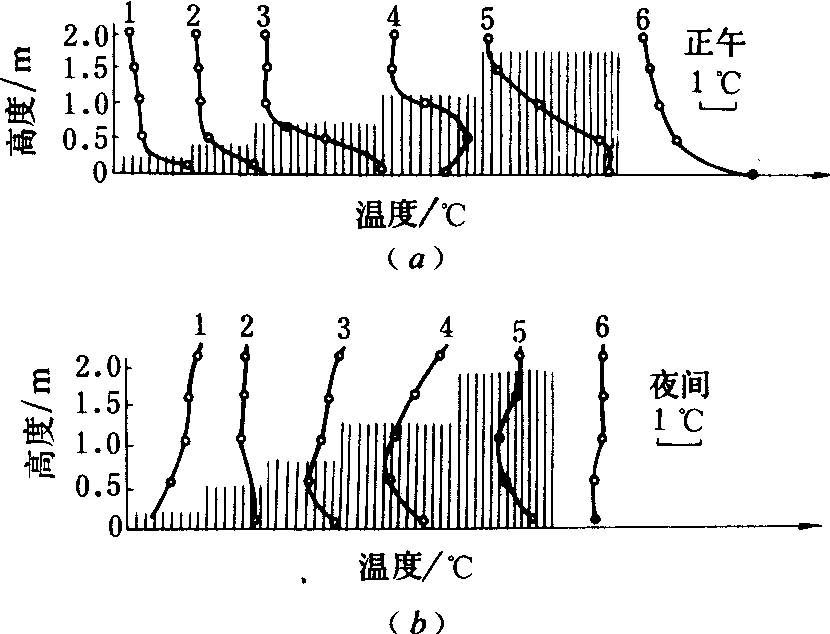
图7 冬大麦地温度的垂直分布
图上序号1、2、3、4、6分别代表4月1~30日、5月1~10日、5月11~20日、5月21~31日、7月26日~8月12日;(a)5代表6月1~30日;(b)5代表6月1日~7月10日
作物地和裸地的气温有很大不同,一般情况白天作物层内由于太阳辐射被削弱,作物层气温要比裸地同高度气温低,夜间则相反(表4)。对于过分密植的作物地,可能全天都是裸地气温高,而对于比较稀疏的作物地,还可观测到作物地气温比裸地高的情况。因为在很密的作物地中,太阳辐射削弱很多,作物地温度自然升不高;在比较稀疏的作物地中,太阳辐射削弱不多,而乱流发展不强,热量不易扩散出去,就有可能使作物地气温反而比裸地气温高。上述情况也符合作物地内外地面温度的对比特点,但对土壤各深度的温度,一般是裸地比作物地高,因为裸地获得的太阳辐射比作物地多,输送到土壤下层的热量也相应多些。
表4 裸地与作物地20厘米高处气温差/℃

水稻田有一水层,其温度状况要特殊一些。在抽穗以前,田间的水面温度比气温高,且以中午差别最大;抽穗后, 由于作物高度增大,到达水面的太阳辐射减少,致使水面温度比气温低(图8)。稻田水层深浅对水温影响很大。白天升温时,浅水田水层的热容量小,增温剧烈,因此浅水田的水温要比深水田水温高;夜间冷却时,深水田因水的热容量大,冷却缓慢,因而温度比浅水田高。
湿度 在作物地中,通常由于总的蒸发增大,乱流扩散减弱,土壤和作物蒸散的水汽不易扩散出去,作物地空气湿度总是比裸地大些 (表5), 且随作物叶面积指数增大而差值增大。
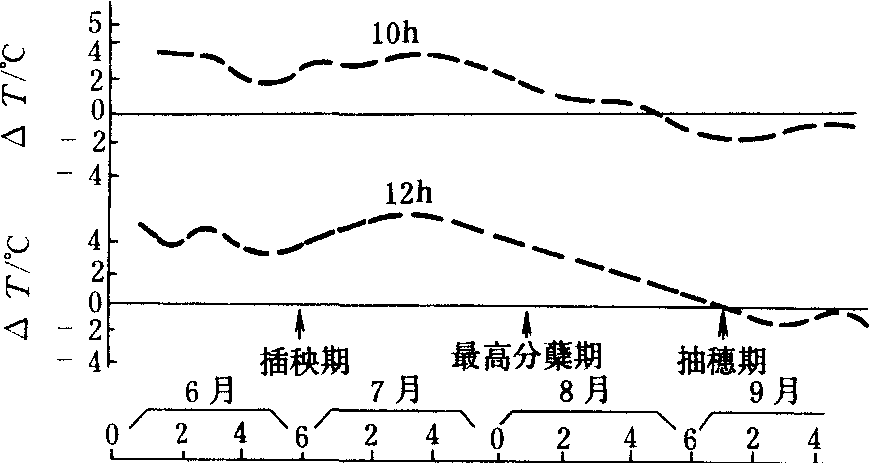
图8 水稻田水温与气温差(△T)的变化
表5 玉米地和裸地上70厘米高处空气湿度差
| 时间/h | 5 | 8 | 11 | 14 | 17 | 20 |
| 绝对湿度/hPa 相对湿度/% | 0.7 6 | 2.3 9 | 2.6 9 | 2.7 20 | 5.9 20 | 2.6 18 |
作物地与裸地空气湿度最大差值发生在白天 (午后),因为此时作物地内、外辐射和乱流条件的差异最大。夜间, 作物地内、外辐射和乱流的差异减小, 因此, 湿度差异也相应减小。空气绝对湿度在作物株间的垂直分布一般是由地面向上递减的, 此种特征以水稻田最为显著。
表6 各种作物对不同风速的减弱效应/%
| 风速/(m/s) | 小 麦 | 大 豆 | 马 铃薯 |
| <1 1~2 2~3 >3 | 24 15 11 9 | 23 20 15 11 | 30 24 23 — |
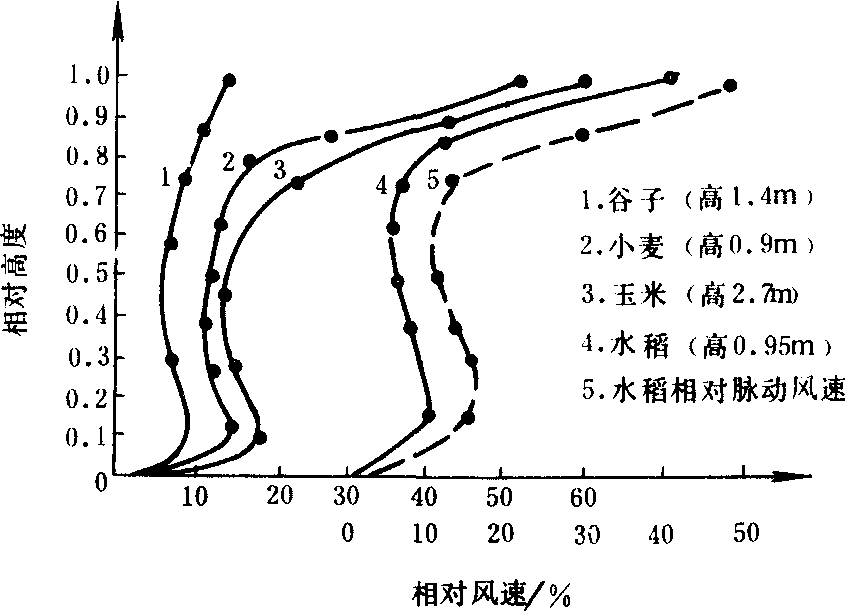
图 9 各种作物地中相对风速的垂直分布
风与乱流 作物地中的风速要比空旷裸地小得多, 这是因为风速受到植株阻挡,产生摩擦作用所致,作物对风速减弱程度有随风速增大而减小、随作物密度增大而增大的特点 (表6)。作物地中风速水平分布和垂直分布的规律, 是由作物地边行向里、由上表面向下不断减弱, 而且最初减弱快, 逐渐变慢, 两者作用结果形成特有的垂直分布形式 (图9)。这种分布形式纯系作物本身结构所造成。在作物中部, 茎、叶稠密, 水平动量输送与垂直动量输送受到较大的削弱,因此风速较小; 在作物上部和下部, 茎、叶相对稀疏,则风速较大。只有在作物地的中央部分, 因边行影响的消失, 风的分布又变成指数形式递减。凡是作物地中风速比较大的地点, 通风条件好, 乱流交换条件也较好; 反之, 在弱风地方, 乱流交换条件就差。作物地中乱流交换强弱与作物密度、离地高度等有关, 一般规律是作物密度愈小, 离地愈高, 交换就愈强, 反之则愈弱。
二氧化碳 农作物在生长发育过程中, 不断消耗CO2制造干物质, 所以须不断从外界得到CO2, 满足作物生长的需要。作物地中CO2主要来自大气和土壤,并通过乱流输送到作物地。输送量的多少取决于乱流交换强弱和作物层与上层大气之间CO2浓度的差值。由于农作物的光合作用和呼吸作用, 使作物地中CO2浓度具有明显的日变化。白天作物地中CO2浓度比较低, 大气是CO2的源地, 作物地是CO2汇地。夜间则相反, 作物地CO2浓度较高, 是CO2源地, 大气则是汇地。由于作物地和大气在昼夜之间交替成为CO2的“源”和“汇”, 使得作物地中CO2浓度的垂直分布具有某些特殊性, 在夜间由于作物的呼吸作用释放CO2,垂直分布曲线由地面向上递减, 称为呼吸型分布; 昼间因作物吸收CO2, 使CO2浓度垂直分布曲线产生弯曲, CO2浓度最低值在作物层某一高度上出现, 并由此向上、向下递增,称同化型分布(图10)。对水平叶较多的作物地,上述垂直变化不明显。天气条件和作物本身生长条件对作物地CO2浓度变化有很大影响,阴天、风速大以及作物叶面积指数小时,作物地中的CO2浓度的变化幅度就减小;反之,辐射强、风速小、叶面积指数大时,变化幅度增大。
了解作物层内CO2的分布情况,对于分析作物地上CO2通量,亦即作物吸收CO2和释放CO2强度的分布,具有重要作用。
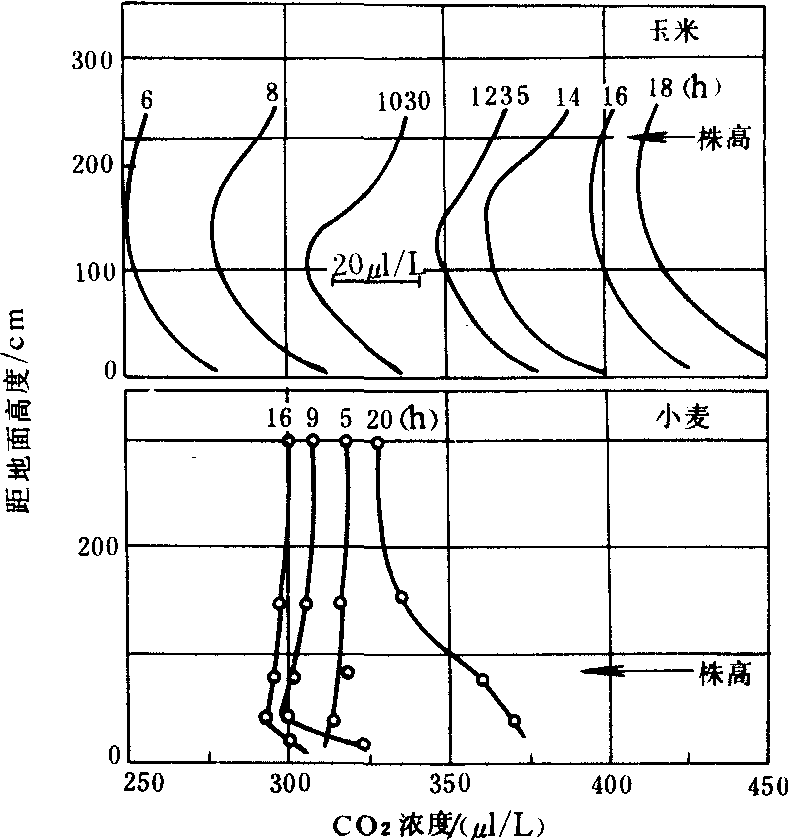
图 10 玉米、小麦地各时刻CO2浓度垂直分布
- wallaby
- Wallace Collection
- Wallace,Alfred Russel
- Wallace,Edgar
- Wallace,George Corley
- Wallace,Henry Agard
- Wallace,Irving
- Wallace,Lewis
- Wallace,Sir William
- Wallachia
- wallaroo
- Wallasey
- wallcreeper
- Wallenburg,Raoul
- Wallenstein,Albrecht Wenzel von
- Waller,Edmund
- Waller,Fats
- walleye
- wallflower
- Wallingford
- Wallis and Futuna lalands
- Wallis,Sir Barnes
- Walloons
- wallpaper
- Wall Street